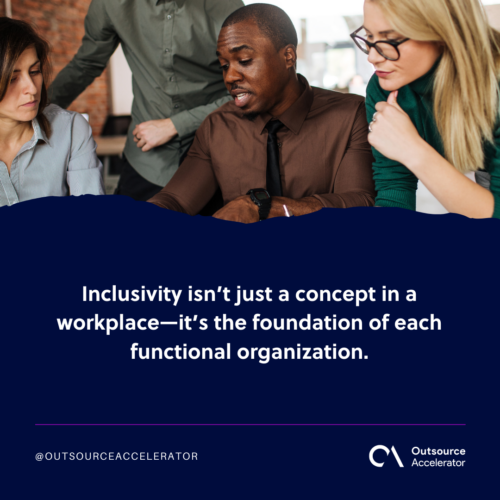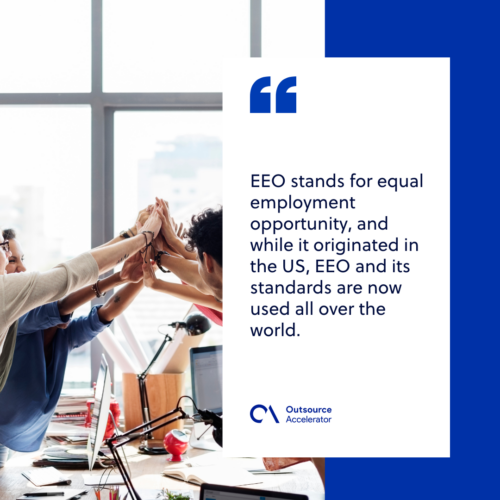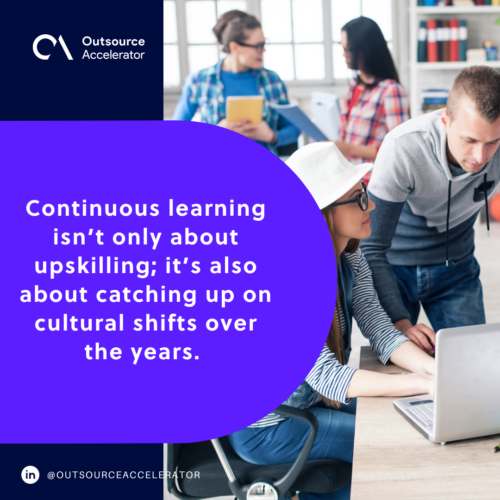A look into inclusivity at work

Inclusivity at work isn’t a foreign concept anymore. It’s one of the top priorities for companies to conduct a healthy environment for their employees and workers.
Nowadays, it’s imperative for workplaces, especially with global teams, to instill a sense of community to ensure productivity and efficiency in their daily operations.
Defining inclusivity
Inclusivity isn’t just a concept in a workplace—it’s the foundation of each functional organization.
It’s a mindset that allows people to be themselves without worrying about prejudices and working in a hostile environment. It’s reflected in the way people talk and act toward others around them.
More importantly, it’s how the system imparts accountability to those who don’t value and treat people equally.

The difference between diversity and inclusion
In the simplest terms, diversity describes the demographics that make up the organization. The greater the differences are in gender, race, age, and other backgrounds, the more diverse an environment is.
On the other hand, inclusion is the system that brings diversity to its full potential. It is ingrained into the culture of an organization.
Diversity can be a manifestation of inclusion, but not all diverse workplaces are inclusive.
What is inclusivity in the workplace?
EEO plays a huge part in promoting inclusivity in the workplace.
EEO stands for equal employment opportunity, and while it originated in the US, EEO and its standards are now used all over the world.
This concept is one of the major propellants of inclusivity at work. An inclusive workplace eliminates discrimination and values contribution from every member of the organization.

Why is inclusivity important in a company?
An inclusive workplace attracts hard workers and honest employees. A healthy work environment has a positive atmosphere that allows everyone to thrive.
Inclusivity is important in a company because it enhances each and every workday for all employees. Dynamic workdays stimulate one’s brain, kicking it into a more productive and creative mode.
A trusted BPO firm like Connext Global Solutions enables you to assemble a more inclusive team through nearshoring.
5 steps to building a more inclusive work environment
Inclusion isn’t something that happens overnight. It’s a series of continuous effort and dedication from the managerial team and the employees as well.
Here are the steps to promote and strengthen inclusivity at work.
1. Giving everyone a voice
Inclusivity at work won’t reach its full potential if there are only a few select individuals who can speak up. From team members to the managers, everyone has the right to be heard.
2. Hearing suggestions and feedback
Feedback forms aren’t just a placebo for employees that have something to point out. It should be a medium of communication for each department to acknowledge different perspectives.
3. Continuous learning
Continuous learning isn’t only about upskilling; it’s also about catching up on cultural shifts over the years.
Inclusivity at work thrives upon a workplace that is open to constant, positive changes.
4. Implementing two-way communication systems
There’s a fine line between talking and maintaining a conversation. Implementing a two-way communication system in the workplace will ensure that everyone has the chance to be heard.
Inclusivity at work happens when everyone is given the floor to speak.
5. Cultivating a collaborative workplace culture
Collaborating with other people can boost camaraderie and morale in the workplace. Cultivating a warm environment is an important step in promoting inclusion in a department.

Benefits of working in an inclusive workplace
Working professionals spend about 30% of their day in the office. That said, it’s a must that their workplace has their best interests at heart.
Here are the benefits of having inclusivity in the office.
Higher morale
In a place where everyone has an equal opportunity, morale would be off the charts. People would contribute more, and daily routines would be so much more meaningful.
Keeping employees happy and validated is key to having a successful business.
More responsive workforce
Speaking of successful businesses, inclusive workplaces have a more responsive workforce. This is because employees feel included in major decision-making processes and internal communications.
When you effectively implement two-way communication systems, as mentioned above, this benefit becomes apparent.
Real work-life balance
When voices are heard and their needs are validated at work, employees’ personal lives get so much lighter. They don’t have to worry about work-related issues or missing out on work when they’re out of the office.\
Maintaining an inclusive workplace in a remote setup
Having to operate in a distributed workforce or a remote work setup is hard enough on its own—especially if you’re not used to it.
The five steps above work, but they may need just a little bit more push. Inclusivity when working remotely may involve using people’s preferred pronouns, making communication more accessible to digital assistants, and more.
In all, inclusivity at work benefits everyone involved. Each generation of departments and batches of employees will have equal opportunities to be the best versions of themselves.







 Independent
Independent




